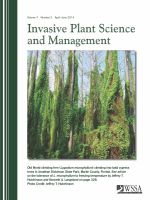Hyparrhenia cymbaria (boat thatching grass, ipopo grass) and Hyparrhenia variabilis (no common name), robust African savanna grasses with complex taxonomies, have not yet been reported for the Americas. Large populations were found in central Jalisco, northeastern Michoacán, and Morelos, Mexico. The species grow in maize and sorghum fields as well as on roadsides and in old fields, but always in association with present or past sorghum cultivation; this suggests introduction through contaminated seed material from Africa. Because of the size and density of the populations, and their native ecology, they are both agricultural pests as well as a potentially dangerous invaders for the American (sub)tropical grasslands and native scrublands, including the southern United States. The invasion underlines the importance of effective phytosanitary controls of the seed supply.
Nomenclature: Boat thatching grass, Hyparrhenia cymbaria (L.) Stapf, Hyparrhenia variabilis Stapf.





